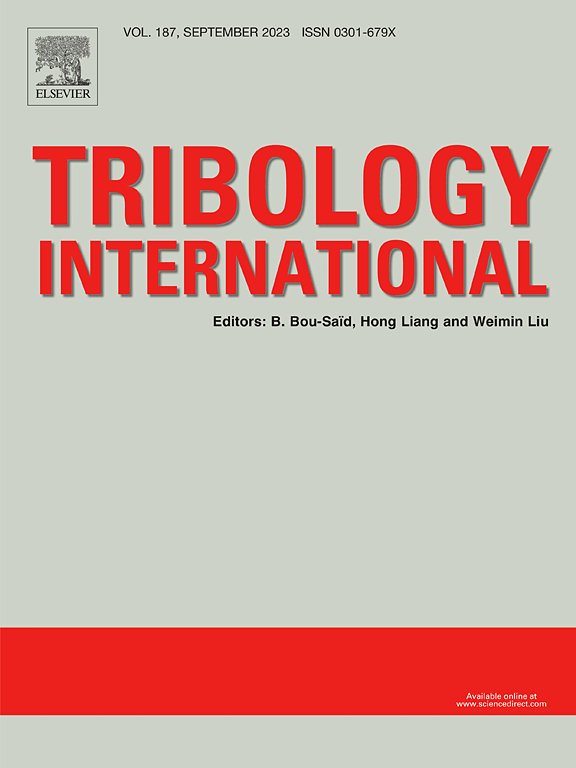电极性:轴承钢润滑磨损的关键因素
IF 6.1
1区 工程技术
Q1 ENGINEERING, MECHANICAL
引用次数: 0
摘要
电动汽车(ev)因其在减少碳排放方面的巨大贡献而受到全球的广泛关注。随着电动汽车普及的加速,了解不同运行条件下电流对润滑油性能的影响变得至关重要。本研究使用电气化球盘摩擦计来研究两种商业化的润滑油,这些润滑油分别适用于电气化和非电气化条件下的传动系统,特别关注球和盘之间的电流方向如何影响润滑剂的行为,从而影响摩擦副的磨损。与未通电测试相比,施加电流对阳极(连接到+)的磨损增加了5 - 10倍。与在1 a和2 a时观察到的磨损相比,在3 a电流下阳极上的磨损减少了50 %。在摩擦试验期间,在低电流水平(1 A和2 A)下观察到磨损碎片粘附在阴极上,在高电流(3 A)下减少或消失。这种碎片粘附有效地减少了负极(连接到-极)的磨损,但同时在阳极上产生磨料磨损。利用x射线光电子能谱、扫描电子显微镜和能量色散x射线能谱对阴极上具有片状形态的传递层进行了表征,并证实了金属铁和氧化铁的存在,以及来自润滑油中极压/抗磨添加剂的硫化物、硫酸盐和磷酸盐的存在。带电磨屑在电场作用下的聚集可以部分解释所观察到的现象。这些结果为设计具有增强抗电流效应的创新添加剂以及旨在减少杂散电流影响的保护涂层提供了重要意义。本文章由计算机程序翻译,如有差异,请以英文原文为准。
Electric polarity: A key factor in lubricated wear of bearing steel
Electric vehicles (EVs) have garnered considerable global attention due to their significant contribution to reducing carbon emissions. As EV adoption accelerates, understanding the effects of electrical currents on lubricant performance under varying operational conditions has become essential. This study used an electrified ball-on-disc tribometer to investigate two commercialized lubricants designed for transmission systems under both electrified and non-electrified conditions, focusing specifically on how the current direction between the ball and the disc influences lubricants behavior and consequently wear of the tribo-pairs. Compared to the non-electrified tests, the application of current increased 5–10-fold wear on the anode (connected to +). This wear on anode decreased by 50 % at a current of 3 A compared to the wear observed at 1 A and 2 A. The adherence of wear debris to the cathode during friction tests was observed at low current levels (1 A and 2 A), diminishing or disappearing at higher currents (3 A). This debris adherence effectively reduces wear on the negative electrode (connected to the - pole) but produces abrasive wear on the anode simultaneously. The transfer layer with patchy like morphology on the cathode were characterized using X-ray Photoelectron Spectroscopy, Scanning Electron Microscopy, and Energy Dispersive X-ray Spectroscopy and confirmed the presence of metallic iron and iron oxide, together with sulfide, sulfate and phosphate derived from the extreme pressure/anti-wear additives in the lubricants. The aggregation of charged wear debris under electric field can partially explain the phenomenon observed. These results offer important implications for the design of innovative additives with enhanced resistance to electric current effects, as well as protective coatings aimed at reducing the impact of stray currents.
求助全文
通过发布文献求助,成功后即可免费获取论文全文。
去求助
来源期刊

Tribology International
工程技术-工程:机械
CiteScore
10.10
自引率
16.10%
发文量
627
审稿时长
35 days
期刊介绍:
Tribology is the science of rubbing surfaces and contributes to every facet of our everyday life, from live cell friction to engine lubrication and seismology. As such tribology is truly multidisciplinary and this extraordinary breadth of scientific interest is reflected in the scope of Tribology International.
Tribology International seeks to publish original research papers of the highest scientific quality to provide an archival resource for scientists from all backgrounds. Written contributions are invited reporting experimental and modelling studies both in established areas of tribology and emerging fields. Scientific topics include the physics or chemistry of tribo-surfaces, bio-tribology, surface engineering and materials, contact mechanics, nano-tribology, lubricants and hydrodynamic lubrication.
 求助内容:
求助内容: 应助结果提醒方式:
应助结果提醒方式:


